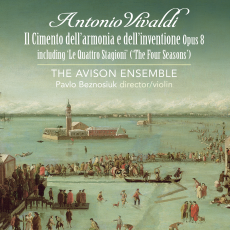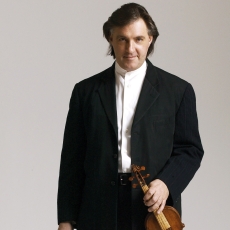The Avison Ensemble - Vivaldi: Concerti Opus 8 - Fanfare
This is a conventional CD release of a recording we reviewed, in SACD form, in Fanfare 35:4. I don’t disagree with Robert Maxham’s comments in that review. Maxham liked the SACDs very much, concluding, “Strongly recommended, in part because of the advantage that SACD sound confers.” Of course that advantage is gone here, but the sound still is very fine, as are the performances, despite Beznosiuk’s “pinched sound.” That sound is attributed, at least partly, to the use of gut strings.
The Four Seasons, the first four concertos in this set, have been recorded so often that ensembles, particularly those playing period instruments, have started to engage in extreme musical behaviors in hopes of being standing out from the pack. That does not happen on the present recording, however. Beznosiuk and the Avison Ensemble are expressive, not hyper-expressive. No show is made out of how fast they can play, of how viciously they can articulate the notes, or of how screamingly loud (or whisperingly soft) they can be. There are little expressive details that impress me, however. For example, in the central movement of “Summer,” the rapidly repeated string notes that Vivaldi uses to imitate thunder are played with a quick and finely judged crescendo, demonstrating the high level of control that the musicians have over dynamic levels. In the following concerto, one can clearly identify when Beznosiuk’s violin has had too much wine to drink. These details do not sound self-indulgent, although they do enliven the performances. I part company with Maxham on the tempo for the central movement of “Winter.” Vivaldi’s marking is Largo, and I like to hear it played as such, even at the risk of “Romanticism.” At best, the present performance is an Andante—too fast for such lovely music. (I’ve heard a few older recordings in which the tempo is slow and the movement is repeated, and I bet that gives the arch-authenticists fits!) Can’t one enjoy a rainy winter afternoon sitting by the fire without having to worry about who is going to feed the kids or fold the laundry?
The Avison Ensemble, whose members are listed in the booklet, include, in addition to Beznosiuk, eight violins, one viola, two cellos, one bass, one archlute/guitar, and harpsichord/organ. The musicians produce a robust sound, but can scale it down to magical effect. Some of their sonorities, especially when they are playing with more legato (not forbidden, fortunately!) have a golden glow that is as unusual as it is appealing. Linn’s engineering probably is positive factor, as is the recording venue—St. George’s Chesterton in Cambridge, England.
This could not be my only recording of opus 8. Sometimes I want to wallow in full-blooded violin tone, and sometimes interpretive extremes are fun. Nevertheless, this is a strong contender in a crowded field, and admirers of period instrument performances are not likely to be disappointed.


